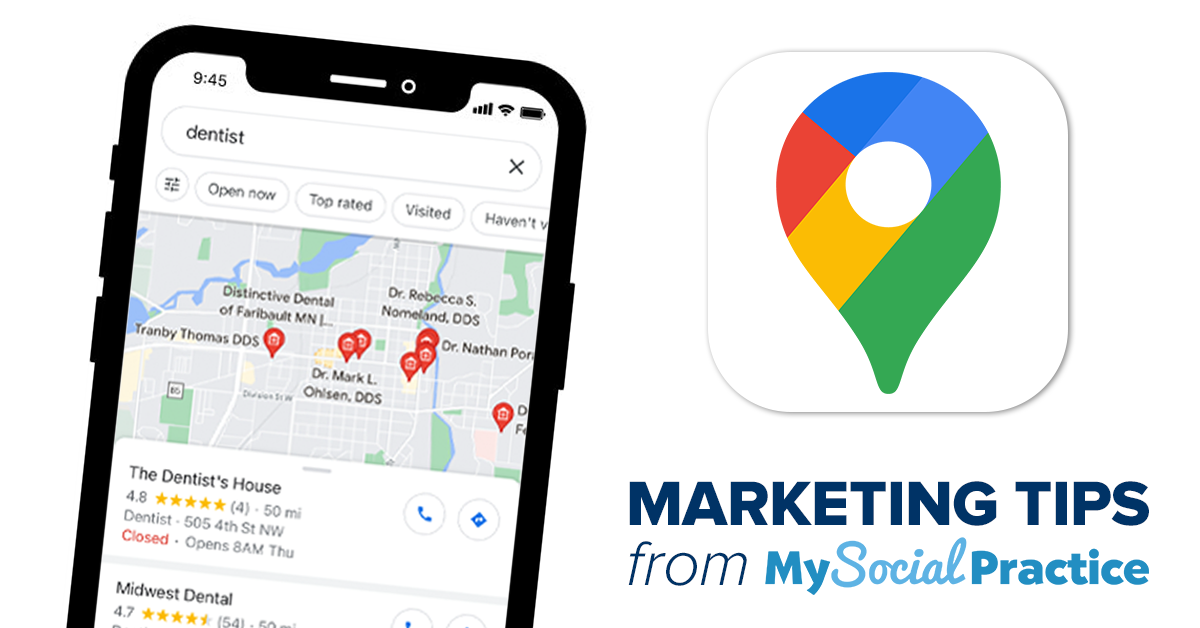How do potential patients find my dental practice on Google Maps? Is there a way to improve how I rank in search engine results? How do I get into the Google Map 3-Pack? Dentists and dental marketing managers looking for new patients are asking these questions.
This local dental search engine optimization (SEO) guide contains valuable information, videos, tips, strategies and directions on optimizing your Google My Business account. No reason to delay; let’s do this.
What is Google My Business (GMB)?
If you are already familiar with your GMB account, go ahead and jump down to the next section. For those of you who are not familiar with your GMB account, you’ll want to read on.
Your GMB account is your business listing in the Google database. When potential patients get online, they can find your listing in a couple of ways; indirect search and direct search.
An Indirect search (AKA discovery search) is when the potential patient searches a phrase that includes a dental category, dental product, or service offered—for example, ‘cosmetic dentists in Dallas.’ Your GMB account will appear with several others on the Google map section of the SERP (Search Engine Results Page). Marketing peeps with the inside scoop refer to this as Local SEO because the results are localized based on your GMB account’s address. Below is an example of a discovery search for ‘Salt Lake City cosmetic dentist.’ The listing on the left of the graphic are GMB accounts.
The second way to find your GMB account is through a direct search. If a potential patient searches your practice name, for example, in the graphic below, I searched, ‘Gateway Dental Arts – Dr. Richard Austin.’ Google will show your knowledge graph on the right-hand side of the screen. Notice that Google doesn’t show any other GMB account information with direct searches because they know that the consumer is looking for you specifically.
Why should you care about local dental SEO?
Recent consumer research studies have shown that consumers trust the results in the Google map over Google ads and organic website results. Simply put, if you can get your GMB listing into the Google map 3-pack (meaning your business is included among the top three local business listings that appear in a Google search result), you’ll get more new patient phone calls.
You should also be aware that online searches in location apps like Google Maps and Apple maps are growing 50% faster than regular browser searches. What does that mean? It means that people are searching your GMB listing, not your website.
If your goal is to find new patients online, the first place to start is your GMB listing.
How do I improve my SEO rankings?
We have put together ten steps to help you with your dental practice SEO.
1. Run a Google maps ranking report
Do you know how well you are ranking on the Google map in the neighborhoods of your city/town?
Before you get started optimizing, check your current rankings by running a Google Maps Ranking Report. You’ll be able to see what areas you’re not ranking well in, which will help to direct you on where to begin your SEO efforts.
2. Claim and verify your Google My Business listing
Before you can do any optimization, you must claim and verify your GMB listing. This step may already have been done for your practice. If you’re not sure though, My Social Practice created a short video explaining how to find your GMB listing and check to see if it’s been claimed and verified. You can watch that video training here.
3. Get familiar with the info tab
Once you’re logged in you’ll see several tabs on the left-hand side of the screen. Find the Info tab and click on it. Almost all the information that shows up in the Google map is updated on the Info tab.
Make sure to scroll through the information on the Info tab and get familiar with it. If you see anything incorrect you can edit and update the information.
4. Check your primary and secondary categories
Your primary category is one of the most important items when it comes to being found in the Google map. If you’re a dentist, you’ll want your primary category to be ‘Dentist’. If you’re an orthodontist, you’ll want your primary category to be ‘Orthodontist’.
Once you’ve chosen your primary category you can add secondary categories. My recommendation (after optimizing hundreds of accounts) is to put no more than two secondary categories. I’ve found the more secondary categories you include the less likely you’ll show up for any of them.
I’ve recorded a short video to help you choose your categories.
5. Fill in all 20 service areas
Google allows you to list up to 20 service areas. Why not just one? It’s because Google knows that dental practices pull patients from all over. So, Google gives you the opportunity to list the areas that you want patients to find you in.
If a potential patient searches ‘veneers in Aurora Co’ and you have Aurora as one of your service areas, you’re more likely to show up on the Google map.
I rarely find dentists who have used up all twenty of the service areas. So, this is definitely an optimization opportunity. Adding service areas does not mean that you’ll automatically show up on the Google map, but you’re more likely to.
Pro tip: The best course of action when choosing your service areas is to run the Google Maps Ranking Report to see where you’re not ranking on the first page of Google for the keywords of which you’re trying to rank.
Below is an example of a Google maps ranking report. The green dots indicate the areas where this client is ranking on the first page of Google for ‘pediatric dentist.’ The yellow and red dots are the areas you’ll want to add to your services areas on the Info tab.
6. Listing your dental services
When a patient searches online for a new dentist, they’ll use different types of search phrases. Some will include your specialty like, ‘dentist near me’ or ‘orthodontist near me’ or ‘oral surgeon near me’, others will include services like ‘cosmetic dentistry near me’ or ‘dental implants near me’ or ‘veneers near me’.
The services that you list in your GMB account help Google to find correlations between your listing and the search phrases. If you have veneers listed as a service you’re more likely to rank higher on the map if someone searches for veneers.
There is no limit to the amount of dental services that you can list in your GMB account. At least not that I’ve found. When we’re hired to perform local search for dentists we’ll add a minimum of 50-75 different services. Don’t scrimp, put in as many as you can think of.
Each service has a description and the description allows for up to 300 characters. I recommend that you enter a description for each service.
Pro tip: Customize your service descriptions by adding service areas. For example, “Here at ABC Dental we are happy to offer veneers to patients in the Miami Beach, FL and surrounding area…”
7. Adding photography to your GMB account
Uploaded photos are displayed on the listings on the Google map and knowledge graph. In several studies of GMB accounts it was found that those accounts with over 100 photos had slightly higher rankings. When you upload a photo, you can place it in one of several categories; interior, exterior, 360, team, at work, identity. You’ll want to make sure you upload photos that will relate to the categories.
Download this complimentary GMB Photo Checklist, which will show you which photos to take and how to frame each shot.
You also select from all the photos that you upload a cover photo and a practice logo image. Your cover and practice photo are very important because they show up front and center on your listing. Google will randomly select them if you don’t select them yourself.
Also, recently Google added a link on the photos section that allows someone to click through directly to your photo categories. In the example to the right you’ll see that you can click through to all photos, including outside photos.
8. Begin posting to your GMB account
Google’s local SEO ranking formula demands that businesses engage with their customers. Just like blogging to your website you can post on your GMB account.
At a minimum we recommend that you post at least 2-4 times per month but if you can post more than that, do it.
Pro tip: Make sure to include a linked button when you post. You’ll want to link to your website, your blog, your social media accounts. The links from your GMB account to all of your other online assets helps your search engine rankings.
9. Acquire more Google reviews and respond
There is no data to suggest that more reviews will increase your rankings, but if you don’t have more reviews than your competition, you won’t be chosen.
A survey done by Iron Monk asked, ‘Which dentist would you most likely pick from a google search?” Here is how the results were broken down:
- 43.3% best online reviews
- 19.4% closest to me
- 18.4% top-ranked
- 14.4% cheapest
- 4.5% best web design
Reviews are a valid social proof statement, because consumers tend to believe what others believe. More reviews will improve phone calls, website visits and scheduled appointments.
So how do you get more Google reviews? The onus is on you and your team. If you don’t A-S-K, you won’t G-E-T. The best way is to ask patients for a review while they’re still in your practice. Many of our internal studies show that patients forget about giving reviews the moment they leave your practice.
Once you’ve received a new Google review it’s very important to reply ASAP. A good rule of thumb is within 24 to 48 hours. In your reply make sure to let them know you appreciate the feedback.
Pro tip: Your GMB account allows you to set up a text notification when you receive a new review. If you do this you’ll never miss receiving one, allowing you to reply quickly.
10. Launch your Google My Business website
The purpose of the GMB website is not to replace your current website. If you don’t have a current dental website, get one. You need a website in today’s digital marketing environment.
The purpose of the GMB website is to provide another way that you can let Google know that you care about your GMB listing. It only takes a couple minutes to launch and once set up it pulls in all of your reviews, posts, photos and practice description from your listing.
Here is an example of an orthodontic GMB website. Notice the text section about half way down and the links to some of their orthodontic services. Those links create an inbound link to their website. That’s really helpful for local SEO.
Bonus help!
Blake Hadley, from My Social Practice, recorded a full ten tips webinar that will walk you through all of the things you need to do to optimize your GMB listing.
Get some help from dental marketing experts
These ten dental SEO tips are just the beginning of local dental SEO. We understand how busy you are. If you’d like someone to take care of this for you don’t hesitate to call My Social Practice.
About the author
Adrian Lefler is the vice president of My Social Practice, where he manages the dental marketing team. If you would like to book Lefler to speak at your event, you can do so on the company’s dental marketing expert page.











You must be logged in to post a comment.